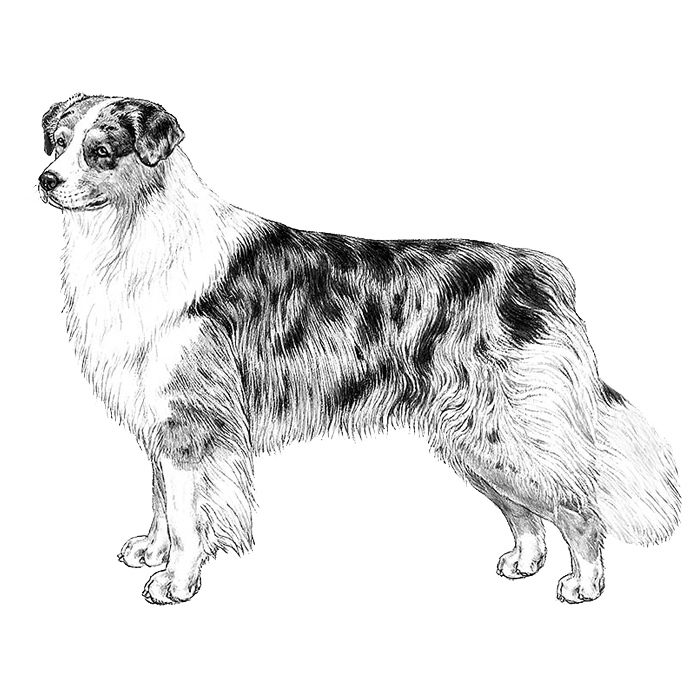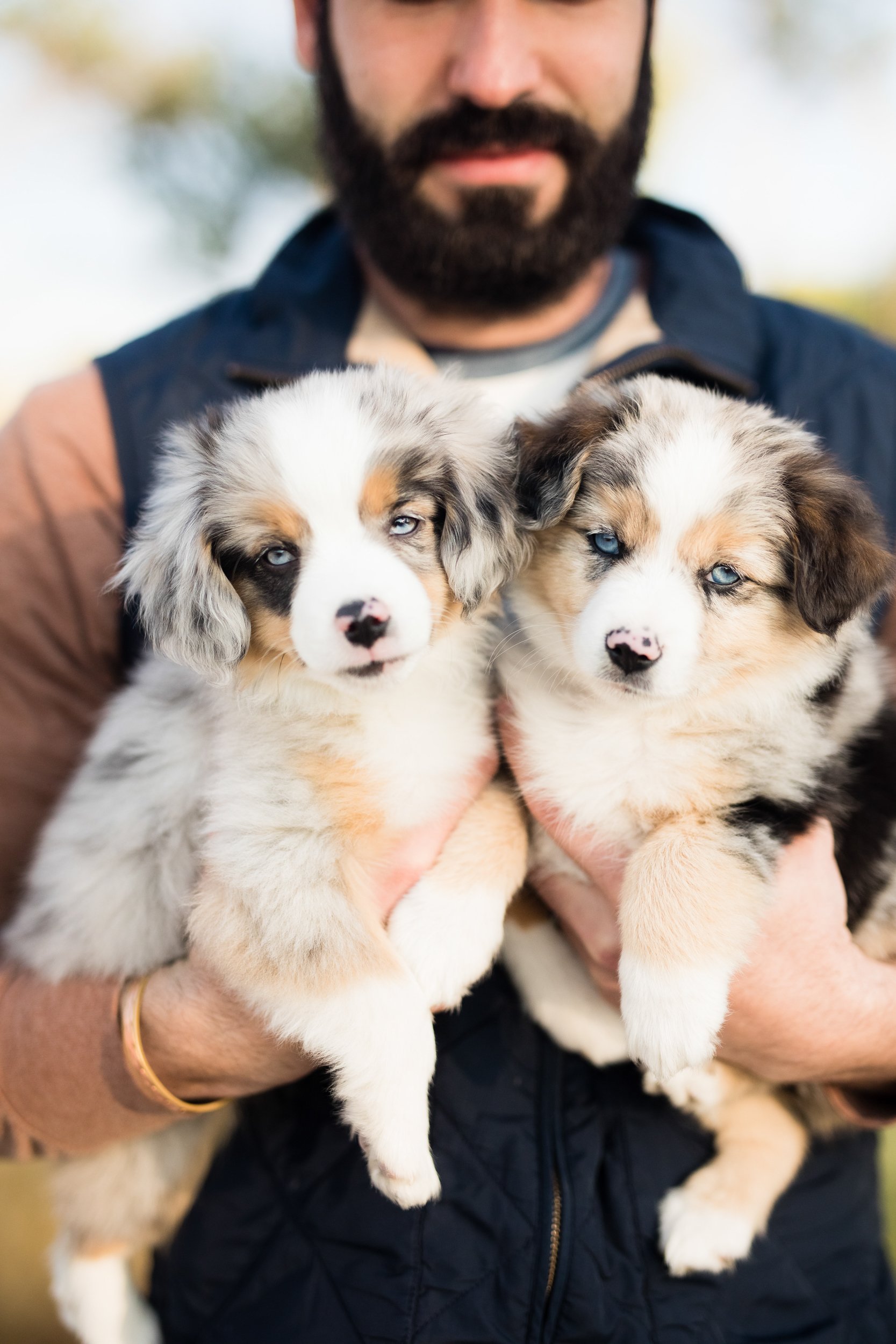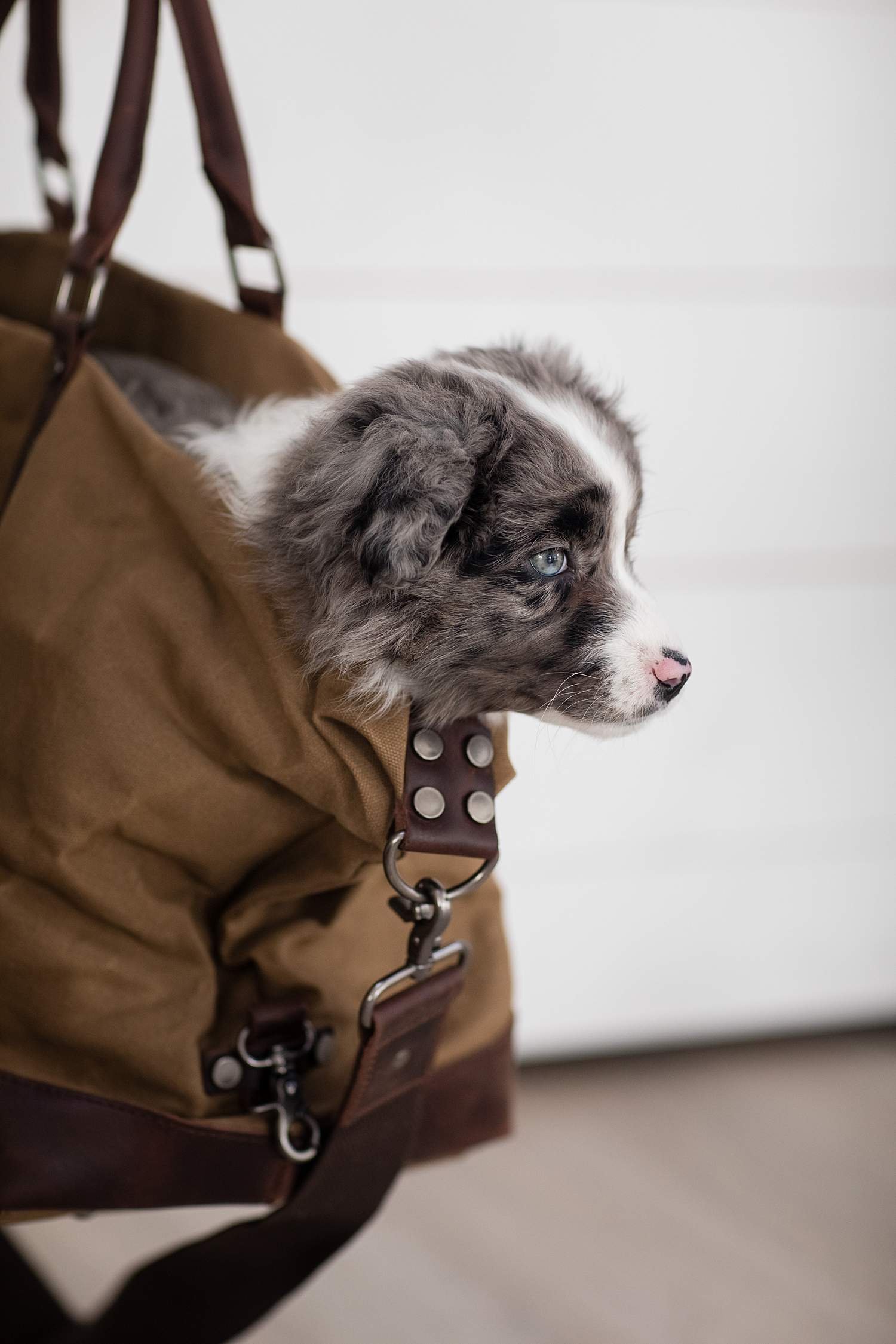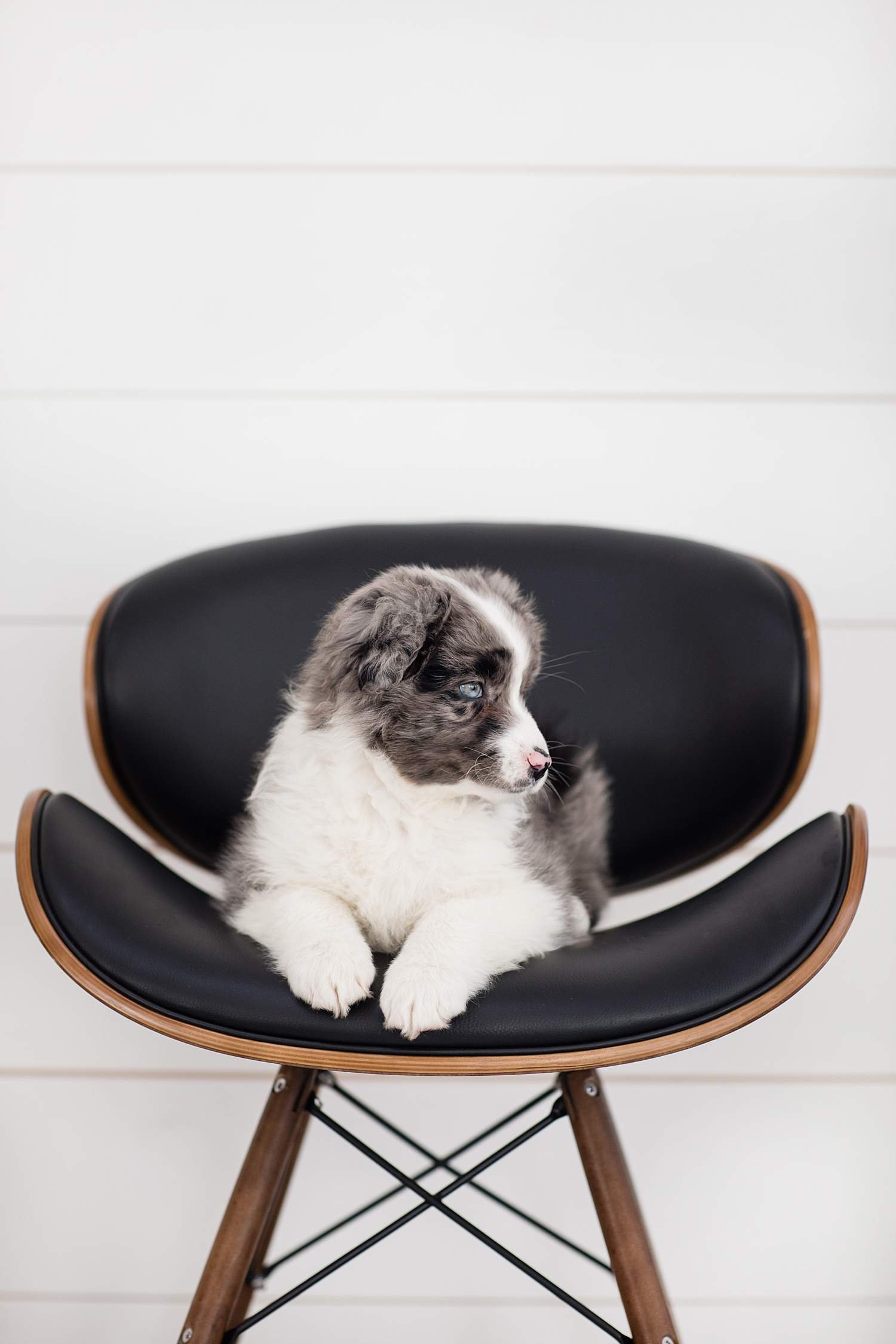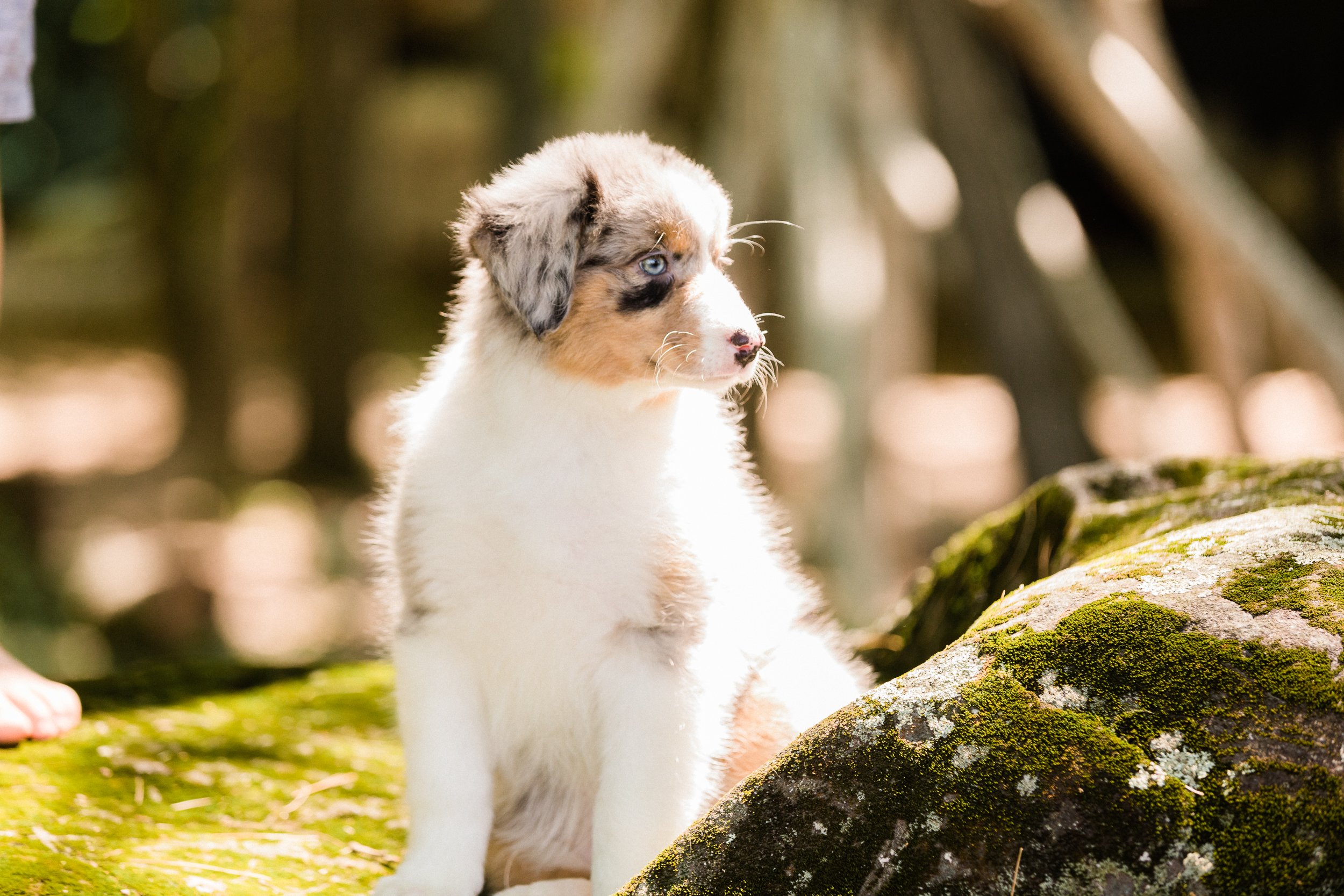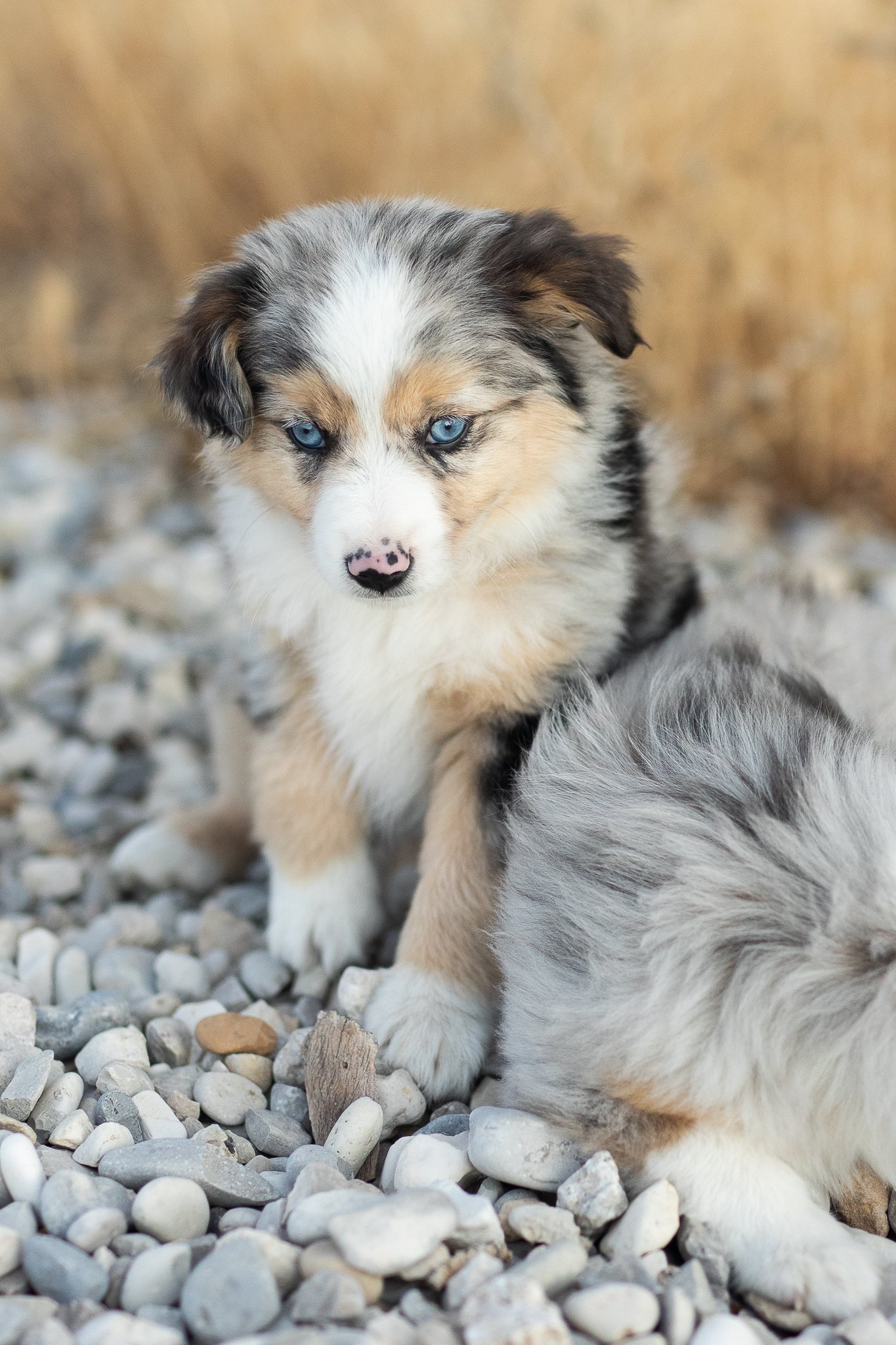Australian Shepherd // Miniature American Shepherd
“Aussie”
“The Australian Shepherd is an intelligent working dog of strong herding and guarding instincts. He is a loyal companion and has the stamina to work all day.”
Australian shepherd/miniature american shepherd
BREED TRAITS & CHARACTERISTICS
Weight: 20 – 31 lbs
Height: 14-18 inches (male), 13-17 inches (female)
Lifespan: 13 years
Introduction
The Australian Shepherd and its smaller counterpart, the Miniature American Shepherd, are two breeds that charm many with their intelligence, energy, and loyalty. They are known for their agility and herding abilities, making them popular choices among dog lovers and breeders alike. If you're considering adding one of these breeds to your family, it's crucial to understand their traits, characteristics, and care needs.
Temperament
Australian Shepherds and Miniature American Shepherds share some notable temperament traits. They are often described as intelligent, trainable breeds that are quick to learn new commands and tricks. Their keen intellect, coupled with their desire to please their owners, makes them excellent candidates for obedience training.
These breeds are also known for their high energy levels and active nature. They thrive in environments where they can run, play, and explore. Keeping them mentally stimulated is equally important as they're prone to boredom when not sufficiently challenged.
Lastly, they are loyal and protective, often forming strong bonds with their families. They have a natural instinct to guard their homes and loved ones, making them excellent watchdogs. However, this protective nature means they can be wary of strangers, and early socialization is crucial to prevent them from becoming overly suspicious or anxious.
Exercise Needs
Both the Australian Shepherd and the Miniature American Shepherd are high-energy breeds that require regular physical exercise to keep them healthy and happy. Activities such as walks, runs, games of fetch, or agility training are excellent ways to burn off some of their energy. Mental stimulation is equally important to keep these smart dogs engaged. Puzzle toys, obedience training, and interactive games can help keep their minds sharp and satisfied.
Training and Socialization
Early training and socialization are crucial aspects of raising a well-rounded Australian Shepherd or Miniature American Shepherd. They are eager learners, and using positive reinforcement techniques can make training sessions fun and rewarding.
Socialization is just as important as training, especially given their protective instincts. Exposing them to a variety of people, environments, and other animals from a young age can help ensure they grow up to be confident and well-adjusted dogs.
Size and Appearance
The Australian Shepherd is a medium-sized breed, typically weighing between 40 to 65 pounds, with a robust and athletic build. They have a thick double coat that can come in a variety of colors, including blue merle, black, red merle, and red—all with or without white markings and/or tan points.
On the other hand, the Miniature American Shepherd shares many physical similarities with its larger counterpart but is significantly smaller, usually weighing between 20 to 40 pounds. Despite their smaller size, they are equally robust and athletic, and their coat colors are also similar to the Australian Shepherd.
Health and Lifespan
Australian Shepherds and Miniature American Shepherds are generally healthy breeds with an average lifespan of 12 to 15 years. However, like all breeds, they are prone to certain health conditions. Common issues include hip and elbow dysplasia, hereditary eye disorders, and certain heart conditions. Regular health check-ups and vaccinations are essential to catch potential health issues early.
Care Tips for Prospective Owners
If you're considering bringing an Australian Shepherd or Miniature American Shepherd into your home, here are some things to keep in mind:
Exercise: Regular physical and mental exercise is essential to keep these breeds healthy and happy. Ensure they have enough room to play and run.
Socialization: Early socialization is crucial. Introduce them to various environments, people, and animals to foster a well-rounded temperament.
Grooming: They have a thick double coat that requires regular brushing to keep it healthy and free from mats.
Diet: A balanced diet is essential for their overall health. Consult with a vet to determine the appropriate food and portion sizes for your dog.
Health Check-ups: Regular veterinary check-ups and keeping up-to-date with vaccinations can help ensure your dog's long-term health.
The "Aussie" shepherd dog is a true American breed, developed in the United States. Its name originates from its Basque shepherd ancestors, who migrated to Australia in the late 19th century and eventually relocated to California and other parts of the US, where they were utilized as cattle dogs. Even today, the Australian Shepherd is still valuable as ranch dogs and trackers and is increasingly treasured as a companion. This breed is one of the most versatile dog breeds, excelling in competitive dog sports, police work, and even as guide dogs due to their high energy and working mentality.
With its penetrating gaze, the Australian Shepherd is a hardy and rustic breed, favored by cowboys as their herding dog of choice. They are medium-sized workers, sporting a range of coat looks, such as merle, which is our personal favorite, displaying a mottled pattern with contrasting shades of blue or red. Aussies are rugged and agile movers of livestock, exhibiting an irresistible impulse. Australian Shepherd: This breed is known for being highly intelligent and energetic, but some individuals may be prone to anxiety.
Miniature American Shepherd = Toy or Miniature Australian Shepherd
The Miniature American Shepherd is similar in appearance to the Australian Shepherd but smaller. They require daily and intensive exercise to keep them happy. They have a lot of energy and enjoy going for long walks and playing.
This breed is great for children and makes a devoted friend and protector. They are easygoing, loyal, and brave. Proper exercise and socialization is important for Miniature Australian Shepherds as they can become anxious and destructive if not given enough attention. They are working dogs and need a sense of purpose.
The Toy Australian Shepherd is easy to train, and they seem to understand what their owner wants. They are eager to please and make great companions. Early training is necessary to prevent them from nipping at people's heels, as they have a natural instinct to herd. Despite their small size, they are true herders and are intelligent, self-motivated workers. They are also loyal and lively companions who love spending time with their owners.
Australian Shepherds Classifications
There are different ways to classify Australian Shepherds, depending on the purpose of the classification. Here are some common classifications:
Breed classification: Australian Shepherds are a breed of herding dog recognized by the American Kennel Club (AKC) and other breed registries. They are classified within the herding group of breeds.
Coat color classification: Australian Shepherds can come in a variety of coat colors and patterns, including black, red, blue merle, and red merle. Some breeders may also classify Australian Shepherds based on the color and pattern of their coat.
Working classification: Australian Shepherds were originally bred to be working dogs, herding livestock and performing other tasks on farms and ranches. Some Australian Shepherds may still be classified as working dogs today, and may compete in herding trials and other working events.
Size classification: Australian Shepherds come in different sizes, including standard, miniature, and toy. The AKC recognizes both the standard and miniature sizes, but the toy size is not recognized by the AKC.
Show classification: Australian Shepherds can also be classified based on their conformation or physical appearance, and may compete in dog shows and other conformation events. The AKC and other breed registries have specific standards for the breed's physical appearance, including size, proportions, and coat characteristics.
The Australian Shepherd is a breed of dog that is recognized by the American Kennel Club (AKC) and other breed registries. The breed standard for the Australian Shepherd describes the ideal physical and temperament characteristics of the breed. Here are some of the key points of the AKC breed standard for Australian Shepherds:
General Appearance: The Australian Shepherd is a well-balanced, medium-sized dog with a slightly longer than tall body. They have a moderate amount of bone and a firm, muscular build. They should look athletic, agile, and attentive.
Coat: The Australian Shepherd's coat is of medium texture, straight to wavy, weather resistant, and of medium length. The undercoat is dense, while the outer coat is of medium texture, straight to slightly wavy, and may be either smooth or slightly coarse. The breed comes in several colors, including black, red, blue merle, and red merle.
Head: The head is clean-cut and strong, with a slightly rounded skull and a well-defined stop. The muzzle is of medium length and tapers slightly to the nose, which is black in color. The eyes are oval-shaped and may be brown, blue, amber, or any combination thereof.
Body: The Australian Shepherd's body is slightly longer than it is tall. The chest is deep and strong, with well-sprung ribs. The back is straight and strong, with a level topline. The tail is either naturally bobbed or docked to a length that will not interfere with the dog's work.
Temperament: The Australian Shepherd is an intelligent, energetic, and affectionate breed. They are known for their loyalty, trainability, and working ability. They may be reserved with strangers but should not be overly shy or aggressive.
Australian Shepherds & Mini American Shephreds as Family Pets
Both Australian Shepherds and Miniature American Shepherds (formerly known as Miniature Australian Shepherds) can make great family pets and companions, provided that they receive the appropriate care, training, and socialization.
Australian Shepherds are known for their intelligence, loyalty, and high energy level. They are often used as working dogs, but can also make great family pets. Australian Shepherds require plenty of exercise and mental stimulation, as well as consistent training and socialization to help them channel their energy in a positive way. They can do well in families with children, but may be reserved with strangers.
Miniature American Shepherds are a smaller version of the Australian Shepherd, and have similar characteristics in terms of temperament and energy level. They are often described as being more reserved with strangers than Australian Shepherds, but can still make great family pets with the right training and socialization. Miniature American Shepherds are also highly trainable and adaptable, which can make them a good choice for families who are willing to put in the time and effort to provide them with the care they need.
Both Australian Shepherds and Miniature American Shepherds can be good choices for families who are looking for an intelligent, active, and loyal companion. However, it is important to remember that each individual dog is unique, and that a dog's temperament and behavior can be influenced by factors such as genetics, socialization, and training. It is important to choose a reputable breeder and to provide your dog with the appropriate care and training to help them become a well-adjusted and happy member of your family.
At Stokehire, we focus at breeding the cherished traits of the Aussie, with Poodles & Bernese to create our pinnacle breed the Australian Mountain Doodle.
Conclusion
The Australian Shepherd and Miniature American Shepherd are charming, intelligent, and energetic breeds that make wonderful companions for the right owners. They're known for their loyalty, agility, and protective nature. However, they require regular exercise, mental stimulation, and early socialization. As with any breed, owning an Australian Shepherd or Miniature American Shepherd comes with responsibilities. If you're prepared to meet their needs, you'll be rewarded with a loyal, loving, and engaging companion. Happy pet parenting!
Quick Facts about Aussies
-
Mouthing is a typical trait for dogs, especially on herding dogs like Australian Shepherds. In most cases, this behavior is totally harmless. However, injuries can be made when your dog becomes aggressive. Owners can use several methods to discourage their pups from mouthing or biting.
Australian shepherds are known for their active lifestyle and high energy. After all, this breed is a herding dog, willing to get rough and active during playtime and duty. Due to their herding instinct, most Aussie pups can’t help themselves and starts mouthing their owners when given a chance.
A mouthing or a bite is usually an act of playfulness on the part of the Aussie pup. When this is the case, the dog would often have a relaxed body and less tension in its face. Jaw pressure from a playful mouthing is less painful or no pain at all. In this case, it all depends on whether the experience is unpleasant to you.
However, some dogs can get aggressive in their mouthing. These instances are often caused by the pup getting a bit more excited. Aggressive mouthing can also happen when the dog is not appropriately trained. Signs of aggression include a stiff body and some wrinkles appearing in your dog’s muzzles.
Aggressive mouthing can turn a simple playtime into an unintended accident. Your dog might not know that it’s hurting you because they don’t have the concept of pain receptors in human’s soft skin. There are instances wherein the dog could not leave the habit behind, which prompts the owner to seek professional vet help.
Mouthing is a natural trait that dogs possess and develop during their younger years. They need to learn how to use their mouths to explore the world and have acquired skills that they need when they’re older. Hence, the mouthing might be caused by a trigger in the environment or situation.
As a herding dog, Australian Shepherds are likely to nibble on your fingers, ankles, or foot. With their herding instinct, Aussie pups are one of the breeds notorious for mouthing. This characteristic is often manifested when the pup enters its “herding mode,” wherein these dogs usually take the assertive attitude.
You might be wondering why Aussies’ herding instinct prompts them to mouth. When herding, the dogs need to keep their sheep and other animals in the right decision. This is done by snapping or nipping at them to go back to the line. It is usually triggered when a group of sheep suddenly goes away or faces the wrong direction.
Another factor to consider as to why a dog will start mouthing is its guarding instinct. A part of the Australian Shepherd’s instinct is to keep its flock safe and away from predators. If an animal which they deem dangerous gets too close to the herd, the Aussies will snap and nip at these predators to keep their herd safe.
When your Australian Shepherd perceives someone as a threat to you or your family members, the dog will likely go to the defensive mode. It will try to bite this person as a warning. However, this behavior can be very annoying, especially if your dog is being super protective. It can be a good or bad thing, depending on the context and the current situation.
Training is an essential part of a dog’s life. Good training and socialization skills can determine whether or not a dog can be a pain in the neck to deal with. While your Australian Shepherd is a pup, teaching it how to do basic commands can ensure that it will not be prone to mouthing incidents.
This can also be said about its social behavior. Puppies with proper socialization training early on are less likely to nip or mouth. A pup can learn to control its nipping and biting by learning with other dogs. It will learn how to stop applying pressure if its playmate gets hurt or yelped while playing.
When in fear or stressed, an Australian Shepherd may try to nip the person who causes it to feel that way. Mouthing is usually a warning, and the dog might get into aggressive mode from its defensive mode. If a dog nips the owner out of fear, it can be an aggressive way to ask for help or call some attention.
Puppies and dogs are quite sensitive to pain. They will likely flinch or nip at a person if they are in pain or are suffering from illnesses. If your pup or dog suddenly started mouthing in your hand, it might be signaling that something’s quite not right in its body. And last but not least, your dog might just be very happy and excited to play with you. The hyperactivity and added tension in your dog’s bite might mislead you that it’s getting pretty aggressive. But in reality, your dog might just be happy to spend some time with you.
You can check if your dog’s behavior is aggressive or not by watching its body language. If it’s in a defensive stance, you might want to back away slowly. Don’t try to run away because your Australian Shepherd will just try to “herd” you by biting at you aggressively.
There are several methods that you can use to administer training and stop your Australian Shepherd from mouthing. Use the best method that you can safely administer at your own home with your dog. Be consistent, and reward your dog every time it successfully manifests your desired behavior.
This method has the name “leave it” because it can help your dog identify the command. First, if your dog starts nipping at you, get a treat and tease it to your dog to catch its interest. Let it sniff at the treat and say “leave it” to establish that those two words are important commands.
When the dog starts to get disinterested or ignore you, praise it with verbal affirmation and let it get the treat. Keep practicing on this until the dog’s behavior is consistent.
To use this method, you need to set the mood and get your pup into mouthing mode. Keep on playing with your dog until it mouths you hard enough that it really hurts. Let your puppy know that you’re hurt by letting your hand go limp and release a high-pitched yelp.
If it works properly, your dog will start becoming gentle with its nipping or even try to stop mouthing. If it stops mouthing, you can encourage this behavior by praising your pup or giving a tasty treat.
As mentioned before, herding dogs are likely to start mouthing when their herding instincts are triggered. Spend some time with your dog, and observe its behavior. Watch out on what’s triggering your dog is going to its herd mode. Once you pinpoint the trigger, you can call for the pup’s attention every time the trigger starts.
Keep doing this until your pup completely stops its mouthing behavior. Most breeds usually outgrow their mouthing or biting tendencies as they get older. The Australian Shepherd is not an exception.
The Socialization Method
This method is effective if the dog is young and hasn’t experienced socialization with other dogs yet. For this method, you need to make sure that there are other dogs or puppies. Just let them play and get rough with each other.
A moment will eventually appear where your puppy will hurt the other dogs due to its inexperience in controlling its jaw’s strength. Much like the bite inhibition method, your dog will likely learn to be careful about its bites.
The Non-Contact Method
And lastly, you can use the non-contact method, which facilitates playtime without touching your puppy. Instead of playing with your puppy or dog by petting and other physical means, you can instead encourage non-contact forms of play.
Training Your Australian Shepherd
If you haven’t trained your Australian Shepherd properly, then this is the perfect time to start. Whatever bad behavior your Shepherd has, whether it’s barking at night or other bad behaviors, using the right training program is the key to having an obedient and happy pup.
Just like other bad behaviors in dogs, aggressive mouthing might or might not be carried into adulthood. Hence, it is quite important to avoid encouraging bad behavior. When it comes to mouthing, here are some things that you should avoid doing while your pet is mouthing. This is an important step to lessen up the chance that your dog will do it again.
Not Giving Them Chew Toys
Dogs are curious creatures, but they use your mouth to test their curiosity. If you want to redirect their mouthing behavior, you must also redirect their attention to you. Hence, giving them something else to chew would be a great option. It will also encourage them to nip at you.
Ignore Your Pup
Even if your puppy is getting troublesome, make it a habit never to ignore them completely. At least, don’t do so without making your pup understand the action that it needs to change or the action that causes you to ignore it. Otherwise, you’ll just let your pup get confused and sad.
Avoid Provoking Gestures
Don’t try to trigger your dog’s biting instinct by making sudden gestures that might cause provocation. For example, if you decide to wake up your sleeping puppy unceremoniously, it will likely take the biting stance and try to bite you immediately. Don’t use exaggerated gestures as well, as it might provoke your dog and trigger its instinct to bite you.
Don’t Avoid Play Time
Avoiding playtime with your dog will not address its aggressive mouthing problem. In fact, it doesn’t solve anything at all. Instead, you should continue interacting with your dog and use it as a chance for training.
Dogs tend to learn quickly, especially herding breeds like Australian Shepherd. Focus on the positive reinforcement of good behavior, and try other options than avoiding your dog entirely.
Avoid Exaggerated Movements
Exaggerated movements like patting at the side of your pup’s face can signal aggression. Examples of this are waving your hand erratically to intimidate the puppy. In return, your dog will likely react aggressively as well. Make your interaction with your pup gentle and laidback. If the puppy is getting aggressive during playtime, you might have to take a break or do other activities.
Don’t Pull Away When Your Pup Mouth.
And last but not least, don’t try to pull your hand away when the puppy is nipping on you. This can cause the pup to grab your hand or bite harder. Instead, stop moving your hand and let it limp, which makes it very uninteresting to your pup.
FAQ
Will Your Australian Shepherd Outgrow Mouthing?
Yes, puppies tend to overgrow their mouthing tendencies and forget this behavior. It is only a temporary phase, and that your pup will likely forget about it with proper training. The majority of the puppies will outgrow this behavior pretty early on.
What Age Do Aussies Stop Mouthing?
The majority of dog breeds will outgrow play-biting or mouthing in about three to five months. With proper training, this can even be shorter. Just give your pup the time it needs, and avoid punishing it for acting on its nature.
Final Thoughts
Mouthing is a normal trait for our canine companions. It’s similar to the experience of closing and clapping your hands for the first time. Your pup will likely outgrow this behavior in a few months.
Take note that aggressive mouthing is another story. It might be better if you ask for help from a vet or a canine behavior expert. Avoid taking actions that might encourage mouthing, and utilize chew toys to break this habit on your fur baby.
Sources:
https://www.aspca.org/pet-care/dog-care/common-dog-behavior-issues/mouthing-nipping-and-biting-puppies
https://wagwalking.com/training/train-an-australian-shepherd-to-not-bite
https://www.animalhumanesociety.org/behavior/managing-mouthing-dogs
https://jubilantpups.com/australian-shepherd-mouthing/
-
Australian Shepherds can make great family dogs for the right households. Here's a breakdown:
Pros: They're typically affectionate, loyal, and intelligent, making them great companions. They're often good with children and can be protective of their family.
Cons: Their energy levels might be too much for some households, requiring plenty of physical and mental stimulation. Without proper exercise, they might exhibit destructive behaviors due to boredom.
-
Yes, to an extent: Their medium-length double coats require regular grooming to manage shedding and prevent matting. They're also high-energy dogs needing ample exercise and mental stimulation.
-
Sometimes called ‘Velcro dogs’, Australian Shepherds are known for their loyalty and attachment to their families. They might exhibit clingy behavior due to their strong bonds and desire to be close to their owners. This clinginess can also stem from separation anxiety if not properly trained or socialized.
-
Pros and Cons:
Pros:
Intelligent and trainable: They excel in obedience and various dog sports.
Versatile: Suitable for various activities like herding, agility, and therapy work.
Affectionate: They're often loving and devoted to their families.
Protective: They can be good watchdogs due to their loyalty.
Cons:
High energy: Need lots of exercise and mental stimulation.
Potential for clinginess: They may develop separation anxiety if left alone for long periods.
Grooming needs: Their coat requires regular maintenance.
Herding Instincts: Might try herding family members or other pets if not trained properly.

